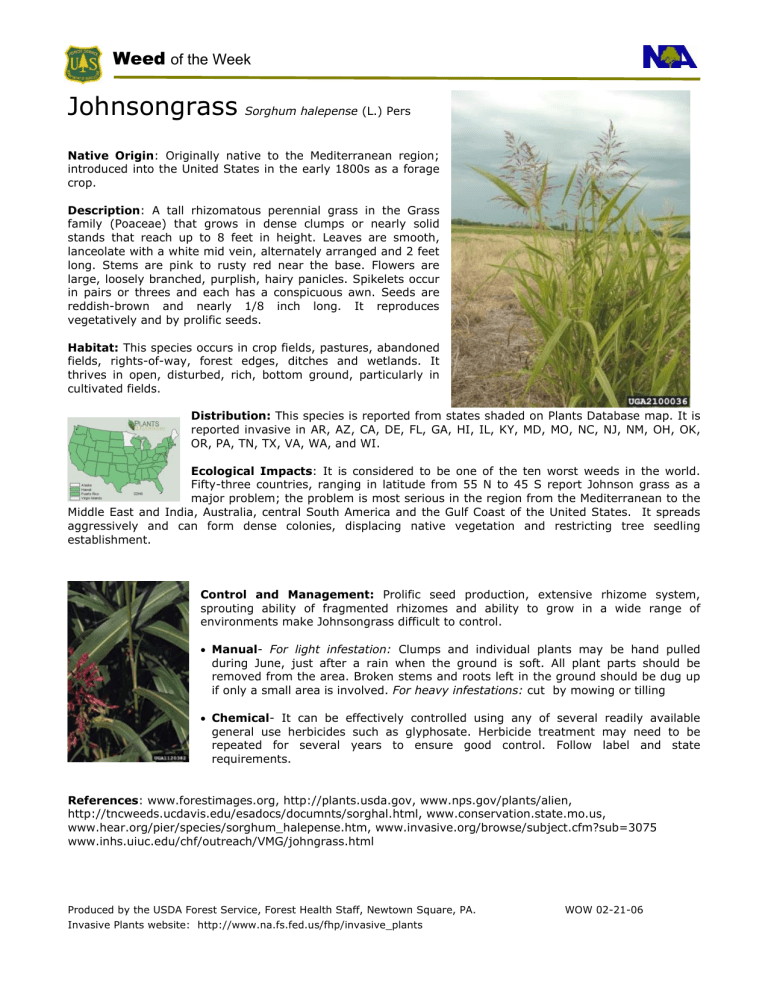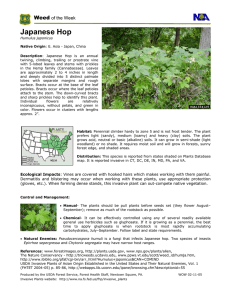Johnsongrass Weed of the Week

Weed
of the Week
Johnsongrass
Sorghum halepense (L.) Pers
Native Origin: Originally native to the Mediterranean region; introduced into the United States in the early 1800s as a forage crop.
Description: A tall rhizomatous perennial grass in the Grass family (Poaceae) that grows in dense clumps or nearly solid stands that reach up to 8 feet in height. Leaves are smooth, lanceolate with a white mid vein, alternately arranged and 2 feet long. Stems are pink to rusty red near the base. Flowers are large, loosely branched, purplish, hairy panicles. Spikelets occur in pairs or threes and each has a conspicuous awn. Seeds are reddish-brown and nearly 1/8 inch long. It reproduces vegetatively and by prolific seeds.
Habitat: This species occurs in crop fields, pastures, abandoned fields, rights-of-way, forest edges, ditches and wetlands. It thrives in open, disturbed, rich, bottom ground, particularly in cultivated fields.
Distribution: This species is reported from states shaded on Plants Database map. It is reported invasive in AR, AZ, CA, DE, FL, GA, HI, IL, KY, MD, MO, NC, NJ, NM, OH, OK,
OR, PA, TN, TX, VA, WA, and WI.
Ecological Impacts: It is considered to be one of the ten worst weeds in the world.
Fifty-three countries, ranging in latitude from 55 N to 45 S report Johnson grass as a major problem; the problem is most serious in the region from the Mediterranean to the
Middle East and India, Australia, central South America and the Gulf Coast of the United States. It spreads aggressively and can form dense colonies, displacing native vegetation and restricting tree seedling establishment.
Control and Management: Prolific seed production, extensive rhizome system, sprouting ability of fragmented rhizomes and ability to grow in a wide range of environments make Johnsongrass difficult to control.
• Manual- For light infestation: Clumps and individual plants may be hand pulled during June, just after a rain when the ground is soft. All plant parts should be removed from the area. Broken stems and roots left in the ground should be dug up if only a small area is involved. For heavy infestations: cut by mowing or tilling
• Chemical- It can be effectively controlled using any of several readily available general use herbicides such as glyphosate. Herbicide treatment may need to be repeated for several years to ensure good control. Follow label and state requirements.
References: www.forestimages.org, http://plants.usda.gov, www.nps.gov/plants/alien, http://tncweeds.ucdavis.edu/esadocs/documnts/sorghal.html, www.conservation.state.mo.us, www.hear.org/pier/species/sorghum_halepense.htm, www.invasive.org/browse/subject.cfm?sub=3075 www.inhs.uiuc.edu/chf/outreach/VMG/johngrass.html
WOW 02-21-06 Produced by the USDA Forest Service, Forest Health Staff, Newtown Square, PA.
Invasive Plants website: http://www.na.fs.fed.us/fhp/invasive_plants



